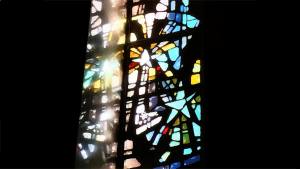This essay first appeared in the October 7, 2018 edition of the Springfield State Journal-Register’s Beliefs column, to which Sister Beth Murphy is a frequent contributor.
“This is a chapel built for the ages!” So exclaimed an awe-struck teenage visitor to Sacred Heart Convent Chapel last spring.
It’s true. The chapel where we Dominican Sisters have prayed for 50 years is beautiful, meaningful and—to the extent that any created thing has longevity—eternal in its purpose and meaning.
It didn’t get that way by accident. If there is anything I’ve come to appreciate during months of preparation for today’s open house at Sacred Heart Convent Chapel, it’s the deep story the chapel tells. I hope you can celebrate with us! (For information visit springfieldop.org/chapel50.)
“It is essentially by the celebration of the mystery of the body of Christ that a place becomes a church,” wrote theologian Yves Congar. The essentials, the altar and the ambo, are where the sacrifice of Jesus is re-presented and where God’s word is proclaimed and preached. The rest, Congar says, is commentary.
So, what does Sacred Heart Convent Chapel, the “commentary” around the altar and ambo, say to us?
Recently Sister Karen Freund mentioned that as a young sister (among the first to make perpetual profession in this chapel) the expansiveness of Gabriel Loire’s magnificent windows helped to open her life of prayer. The windows “surround us with grace” she said, and are a visual embodiment of the evolution of religious life. “It’s not just ‘Jesus make me holy,’” she said. “It’s concern for all those ways in which the holiness of the whole people is disturbed by what needs mercy, and justice, and peace.”
An introduction to a catalogue of Loire’s work makes a similar point about stained glass. Nothing prevails against the “intangible transparency” of the glass, though it seems a mark of vulnerability. It is that very transparency which allows into the church the needs of the world, symbolized by the light raining into a space through Loire’s windows.
So, our chapel is a kind of dialog with the world. Its altar and ambo unite us with the most ancient Christian tradition. Everything else—the “commentary”—flows from decades of conversation about the nature of religious art and architecture and the place of faith in the world.
In 1932 Pope Pius XII wrote that modernism was fine for churches if the forms were beautiful and “cultivated by the two-fold light of genius and faith.” Yes, said the French Dominican Marie-Alain Couturier, like Loire an accomplished glazier and influencer of the modern sacred art movement. “Without doubt it’s better to have geniuses with faith, but if one can’t find them, geniuses without faith are still preferable to believers without talent.”
So it’s fascinating to me that the primary vision for our chapel—a setting for the jewels of Loire windows and magnificent venetian glass mosaics—came to us through the genius of a man who may have been considered back in the day a “non-believer.” Aden Lauchner, who died almost a year ago, was the lead designer for our convent. In 1962 he worked at Hadley and Worthington, the deeply Catholic architectural firm that received most of the diocesan commissions at that time. This week I had the pleasure of talking with Mary Lou Lauchner to express my gratitude for her late husband’s gift to us. It gives me joy today, in this era of interfaith cooperation and dialogue, that Mr. Lauchner and at least two others on our project were members of the Bahai’ community. The Bahai’ creed of unity is deeply in sync with Jesus’ desire “that they may be one.” That’s as pleasing to the soul as Aden Lauchner’s creative vision is to our eyes.


